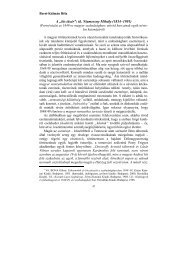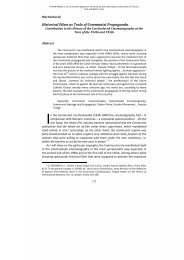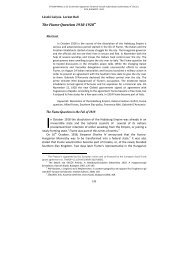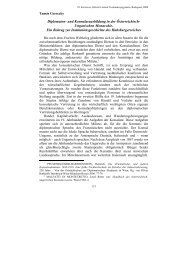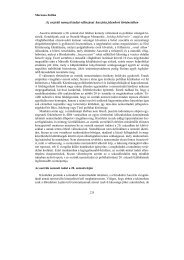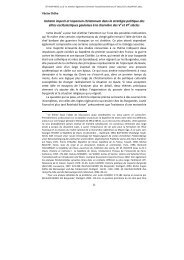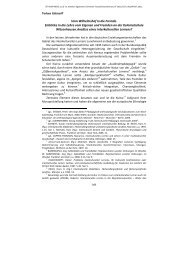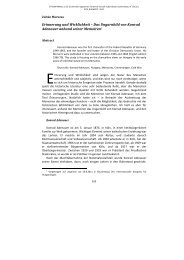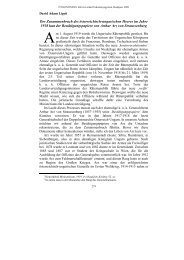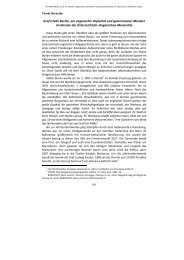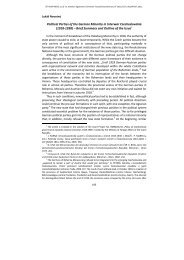The Molotov-Ribbentrop Pact - ELTE BTK Történelem Szakos Portál
The Molotov-Ribbentrop Pact - ELTE BTK Történelem Szakos Portál
The Molotov-Ribbentrop Pact - ELTE BTK Történelem Szakos Portál
Create successful ePaper yourself
Turn your PDF publications into a flip-book with our unique Google optimized e-Paper software.
individual offenders, 10 who used his granted freedom within the system, not<br />
least to satisfy his own interests at the expense of whole groups of population,<br />
what further radicalized the apparatus, was Adolf Eichmann. 11<br />
Eichmann's assessment in the literature<br />
<strong>The</strong> assessment of Eichmann and his role in the Nazi apparatus in the<br />
literature has to be understood in the context of the discourse of conflicting<br />
interpretations 12 of the development of Nazi genocide policy.<br />
10 If this work is primarily about the person of Adolf Eichmann, it must no be forgotten, that<br />
he didn’t work all alone. <strong>The</strong> careers of the so-called „Eichmann-Männer” („Eichmann-Men”), a<br />
term from Raul HILBERG, which initially referred to the three commanders of the camp in<br />
<strong>The</strong>resienstadt, Dr. Siegfried Seidl, Anton Burger und Karl Rahm are treated in the books listed<br />
below, especially at Raul HILBERG and Hans SAFRIAN. Since I will not explain any further<br />
details about Eichmann’s Men, in trying to keep this work as short as possible, they should be<br />
briefly mentioned here: Franz Novak born 1913 in Wolfsberg in the Austrian province of<br />
Carinthia; Alois Brunner,1912 in Rohrbrunn in Burgenland; Anton Burger,1911 in Neunkirchen<br />
in Lower Austria; Karl Rahm, 1907 in Klosterneuburg near Vienna; Franz Stuschka, 1910 in<br />
Liesing near Vienna; Herbert Gerbing, 1914 in Mödling near Vienna; Anton Zita, 1909 in<br />
Göllersdorf; Josef Weiszl, 1912 in Felsöderna; Richard Hartenberger, 1911 in Vienna; Ernst<br />
Girzick, 1911 in Vienna; Ferdinand Daurach, 1912 in Vienna; Ernst Brückler, 1912 in Vienna;<br />
Alfred Slawik, 1913 in Vienna; Anton Brunner, 1898 in Bregana. LOZOWICK describes this<br />
group of men in this way: „Although their social backgrounds and education varied, they were<br />
all young, male, Christian, and nationalist-minded Germans; they had all voluntarily joined the<br />
SS.” LOZOWICK Yaacon: Hitler’s Bureaucrats. <strong>The</strong> Nazi security police and the banality of<br />
evil. Leicester, 2002. 7.<br />
11 SAFRIAN, Hans: Eichmann’s Men. 2010. 1 -13.<br />
12 Such an attempt of interpretation, called „intentionalistic” in literature, assumes, says<br />
Eberhard Jäckel, a linear implementation of a „world view”. Also the English historian Gerald<br />
Fleming makes in his work „Hitler and the Final Solution” clear, that it is a straight way from<br />
the anti-Semitic statements of the young Adolf Hitler. Related to Hitler’s remark to his childhood<br />
friend August Kubizek: „that does not belong here in Linz”, as the two passed the small<br />
synagogue in the Bethlehemstraße in Linz. In: FLEMING, Gerald: It Is the Fuehrer’s Wish.<br />
Extract reprinted from Fleming’s „Hitler and the Final Solution”. In: NIEWYK, Donald L., ed.<br />
<strong>The</strong> Holocaust: Problems and Perspectives of Interpretation, 2 nd ed. Boston, 1997. 12-13. Read<br />
in: SAFRIAN, Hans: Eichmann’s Men. 9. Up to the so-called „Final Solution of the Jewish<br />
Question” followers of this attempts of interpretation, called „Intentionalists” thus trying to draw<br />
a direct line between the anti-Semitic ideology of Hitler, his plans and orders and the mass<br />
murders. In contrast followers of the so-called „structuralistic” or also „functionalistic” attempt<br />
of interpretation deny such a „master plan of evil”, that led to the „Final Solution”. So<br />
SCHLEUNES, Karl A. speaks in his researches about a „tortuous road to Auschwitz”. Also<br />
historians like BROSZAT, Martin and MOMMSEN, Hans refer to a „cumulative radicalization”<br />
of the Nazi actions against humanity. Simultaneously they relativize the importance of a clear<br />
and unequivocal command of Hitler for the carrying out of the mass murders. In that case the<br />
Nazi-genocide-policy is no direct implementation of an ideology, but had to be understood as a<br />
complex branching and Step-by-step aggravatation of individual motives, as well as the<br />
interaction and bundling of various moments. SAFRIAN, Hans: Eichmann’s Men 9-11. A third<br />
attempt of interpretation of the genocides, which is for example made by STRAUSS, Herbert A.,<br />
speaks about the fundamental incomprehensibility of the „Holocaust”. DAN, Diner calls,<br />
77



